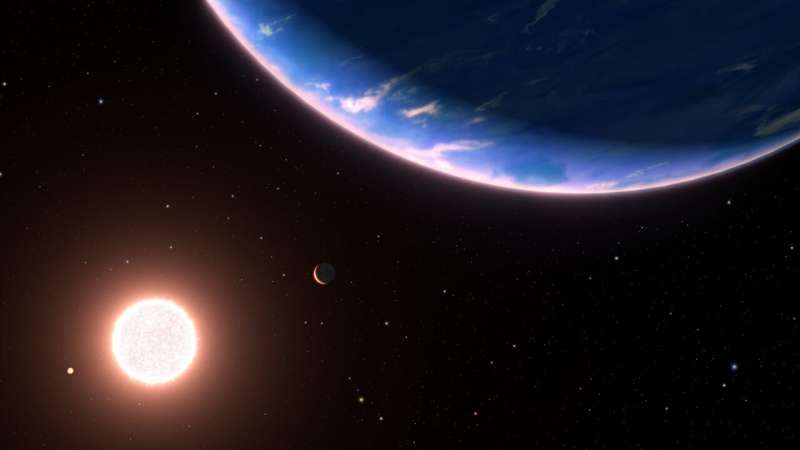This article has been reviewed according to Science X's editorial process and policies. Editors have highlighted the following attributes while ensuring the content's credibility:
fact-checked
peer-reviewed publication
trusted source
proofread
Hubble finds water vapor in small exoplanet's atmosphere

Astronomers using the NASA/ESA Hubble Space Telescope observed the smallest exoplanet where water vapor has been detected in its atmosphere. At only approximately twice Earth's diameter, the planet GJ 9827d could be an example of potential planets with water-rich atmospheres elsewhere in our galaxy.
GJ 9827d was discovered by NASA's Kepler Space Telescope in 2017. It completes an orbit around a red dwarf star every 6.2 days. The star, GJ 9827, lies 97 light-years from Earth in the constellation Pisces.
"This would be the first time that we can directly show through an atmospheric detection that these planets with water-rich atmospheres can actually exist around other stars," said team member Björn Benneke of the Université de Montréal. "This is an important step toward determining the prevalence and diversity of atmospheres on rocky planets."
The study is published in The Astrophysical Journal Letters.
However, it remains too early to tell whether Hubble spectroscopically measured a small amount of water vapor in a puffy hydrogen-rich atmosphere, or if the planet's atmosphere is mostly made of water, left behind after a primeval hydrogen/helium atmosphere evaporated under stellar radiation.
"Our observing program was designed specifically with the goal of not only detecting the molecules in the planet's atmosphere, but of actually looking specifically for water vapor. Either result would be exciting, whether water vapor is dominant or just a tiny species in a hydrogen-dominant atmosphere," said the paper's lead author, Pierre-Alexis Roy of the Université de Montréal.
"Until now, we had not been able to directly detect the atmosphere of such a small planet. And we're slowly getting into this regime now," added Benneke. "At some point, as we study smaller planets, there must be a transition where there's no more hydrogen on these small worlds, and they have atmospheres more like Venus (which is dominated by carbon dioxide)."
Because the planet is as hot as Venus at roughly 425°C, it definitely would be an inhospitable, steamy world if the atmosphere were predominantly water vapor.
At present the team is left with two possibilities. The planet is still clinging to a hydrogen-rich envelope laced with water, making it a mini-Neptune. Alternatively, it could be a warmer version of Jupiter's moon Europa, which has twice as much water as Earth beneath its crust. "The planet GJ 9827d could be half water, half rock. And there would be a lot of water vapor on top of some smaller rocky body," said Benneke.
If the planet has a residual water-rich atmosphere, then it must have formed farther away from its host star, where the temperature is cold and water is available in the form of ice, than its present location. In this scenario, the planet would have then migrated closer to the star and received more radiation. The hydrogen was then heated and escaped, or is still in the process of escaping, the planet's weak gravity. The alternative theory is that the planet formed close to the hot star, with a trace of water in its atmosphere.
The Hubble program observed the planet during 11 transits—events in which the planet crossed in front of its star—that were spaced out over three years. During transits, starlight is filtered through the planet's atmosphere and carries the spectral fingerprint of water molecules. If there are clouds on the planet, they are low enough in the atmosphere that they don't completely hide Hubble's view of the atmosphere, and Hubble is able to probe water vapor above the clouds.
Hubble's discovery opens the door to studying the planet in more detail. It's a good target for the NASA/ESA/CSA James Webb Space Telescope to do infrared spectroscopy to look for other atmospheric molecules.
More information: Pierre-Alexis Roy et al, Water Absorption in the Transmission Spectrum of the Water World Candidate GJ 9827 d, The Astrophysical Journal Letters (2023). DOI: 10.3847/2041-8213/acebf0
Journal information: Astrophysical Journal Letters
Provided by European Space Agency




















